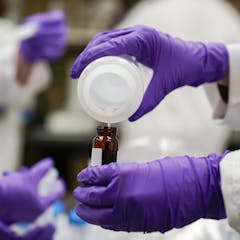
Articles on PFAS
Displaying 1 - 20 of 45 articles

Corporations have an incentive to make profits – even if their products hurt or even kill people. Here’s how to stop history repeating.

Mountain tourism brings revenues to Nepal but leaves a mess behind. Local and international groups are offering new cleanup strategies.

I hate telling people I’m a chemist – but chemistry is the central science of the modern world.

In Australia, the taxpayer has footed the bill for the forever chemical clean-up so far. But this will have to change.

Filtering out PFAS is only the first step. These ‘forever chemicals’ still have to be destroyed, and there are many questions about how to do that safely.

These chemicals are now found on almost every part of the planet, including in the bodies of a large percentage of the American public. An environmental health scientist explains the risks.

Huge amounts of PFAS come from wastewater treatment plants, new study finds.

Synthetic chemicals found in ski wax have been found in the snow and soil on ski slopes and could pose a toxic threat to the environment.

They have properties that make them essential for many products.

Researchers are finding alarming concentrations of persistent pollutants such as PFAS in Australian dolphins. These record-breaking levels are cause for concern.

Scientists found PFAS hot spots in Miami’s Biscayne Bay where the chemicals are entering coastal waters and reaching the ocean. Water samples point to some specific sources.

Recently published research is showing PFAS chemicals may be even more harmful than we thought.

Focusing solely on humans at the expense of other life in the aftermath of train derailments limits the effectiveness of our disaster response management.

Paper and bamboo straws contain ‘forever chemicals’ – maybe threatening the health of people and wildlife.

New restrictions on PFAS and other potentially hazardous chemicals in Australia present an opportunity for industry to develop alternatives for new, safe and clean products.

The Canadian government needs to regulate and, eventually, stop the continued release of toxic ‘forever chemicals’ into the environment and also prevent the creation of any toxic replacements.

PFAS can be filtered, but getting rid of the chemicals is a monumental challenge. A biochemist and soil scientist explain.

PFAS are chemicals used in cosmetics and personal care products that can persist in the environment for a very long time. New regulations seek to ban PFAS, but Canada needs to take further actions.

Most food in Australia remains free of PFAS, but a new study has found it can build up in cattle on PFAS-affected farms. But there are ways to manage the land and livestock to reduce the risks.

The drinking water systems serving over 70 million people may not meet newly proposed water quality standards. It could cost hundreds of billions of dollars to fix that.
